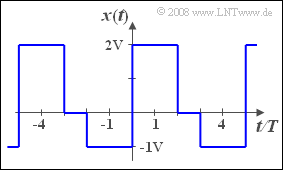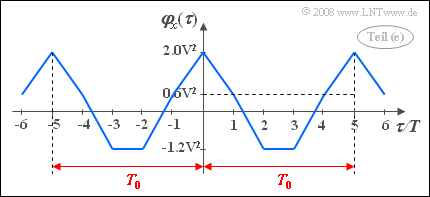Difference between revisions of "Aufgaben:Exercise 4.09Z: Periodic ACF"
m (Nabil verschob die Seite Zusatzaufgaben:4.09 Periodische AKF nach 4.09Z Periodische AKF) |
|||
| (16 intermediate revisions by 4 users not shown) | |||
| Line 1: | Line 1: | ||
| − | {{quiz-Header|Buchseite= | + | {{quiz-Header|Buchseite=Theory_of_Stochastic_Signals/Auto-Correlation_Function |
}} | }} | ||
| − | [[File:P_ID380__Sto_Z_4_9.png|right|]] | + | [[File:P_ID380__Sto_Z_4_9.png|right|frame|Periodic multilevel rectangular signal]] |
| − | + | We consider in this exercise a periodic and simultaneously ergodic stochastic process $\{x_i(t)\}$, which is fully characterized by the presented pattern function $x(t)$. | |
| − | + | Further pattern signals of the random process $\{x_i(t)\}$ are obtained by shifting by different delays $\tau_i$, where $\tau_i$ is assumed to be uniformly distributed between $0$ and the period $T_0$. | |
| − | |||
| + | '''Hint:''' The exercise belongs to the chapter [[Theory_of_Stochastic_Signals/Auto-Correlation_Function|Auto-Correlation Function]]. | ||
| + | |||
| − | === | + | |
| + | ===Questions=== | ||
<quiz display=simple> | <quiz display=simple> | ||
| − | { | + | {Determine the period duration $T_0$ normalized to the period duration $T$ defined in the sketch. |
|type="{}"} | |type="{}"} | ||
| − | $T_0/T$ | + | $T_0/T \ = \ $ { 5 3% } |
| − | { | + | {What is the size of the DC signal component ⇒ linear mean $m_x$ of the described process $\{x_i(t)\}$? |
|type="{}"} | |type="{}"} | ||
| − | $m_x$ | + | $m_x \ = \ $ { 0.4 3% } $\ \rm V$ |
| − | { | + | {What is the process power (related to the resistor $1 \hspace{0.05cm} \rm \Omega$ )? |
|type="{}"} | |type="{}"} | ||
| − | $P_x$ | + | $P_x \ = \ $ { 2 3% } $\ \rm V^2$ |
| − | { | + | {Calculate the ACF values for $\tau = T$ and $\tau = 2T$. |
|type="{}"} | |type="{}"} | ||
| − | $\ | + | $\varphi_x(\tau = T) \ = \ $ { 0.6 3% } $\ \rm V^2$ |
| − | $\ | + | $\varphi_x(\tau = 2T) \ = \ $ { -1.236--1.164 } $\ \rm V^2$ |
| − | { | + | {Sketch the ACF curve taking into account symmetries. What values result for $\tau = 3T$ and $\tau = 4T$? |
|type="{}"} | |type="{}"} | ||
| − | $\ | + | $\varphi_x(\tau = 3T) \ = \ $ { -1.236--1.164 } $\ \rm V^2$ |
| − | $\ | + | $\varphi_x(\tau = 4T)\ = \ $ { 0.6 3% } $\ \rm V^2$ |
| − | { | + | {Calculate the expected value of the ACF with respect to all $\tau$ values. Interpret the result. |
|type="{}"} | |type="{}"} | ||
| − | $E[\ | + | ${\rm E}\big[\varphi_x(\tau)\big]\ = \ $ { 0.16 3% } $\ \rm V^2$ |
</quiz> | </quiz> | ||
| − | === | + | ===Solution=== |
{{ML-Kopf}} | {{ML-Kopf}} | ||
| − | [[File:P_ID382__Sto_Z_4_9_d.png|right|]] | + | [[File:P_ID382__Sto_Z_4_9_d.png|right|frame|For the ACF calculation]] |
| − | : | + | '''(1)''' The (normalized) period duration is $T_0/T \hspace{0.15cm}\underline{= 5}.$ |
| + | |||
| + | |||
| + | '''(2)''' Due to periodicity, the averaging over a periodic time $T_0$: | ||
| + | :$$m_x = \frac{1}{T_0} \cdot \int_0^{T_0} x(t) \hspace{0.1cm}{\rm d} t = \frac{1}{5 T} \cdot (2\hspace{0.05cm}{\rm V} \cdot 2 T - 2\hspace{0.05cm}{\rm V} \cdot 2 T) \hspace{0.15cm}\underline{= \rm 0.4 \,V}.$$ | ||
| + | |||
| + | |||
| + | '''(3)''' In analogy to the last subtask, we obtain for the mean power: | ||
| + | :$$P_x = \frac{2 T}{5 T} \cdot \big[(\rm 2V)^2 +(- \rm 1V)^2 \big]\hspace{0.15cm}\underline{ = \rm 2 \,V^2}.$$ | ||
| + | |||
| + | |||
| + | '''(4)''' The accompanying graph shows in each case in the range from $0$ to $T_0 = 5T$. | ||
| + | :*above the product $x(t) \cdot x(t+T)$, | ||
| + | :*down the product $x(t) \cdot x(t+2T)$. | ||
| + | |||
| + | |||
| + | *Note that $x(t+T)$ means a shift of the signal $x(t)$ by $T$ to the left. | ||
| + | |||
| + | *From these sketches follow the relations: | ||
| + | :$$\varphi_x (T)= \rm {1}/{5 } \cdot (\rm 4V^2 + \rm 1V^2 - \rm 2V^2) \hspace{0.15cm}\underline{= \rm 0.6\, V^2},$$ | ||
| + | :$$\varphi_x ( 2 T)= \rm {1}/{5 } \cdot(-\rm 2V^2 \cdot 3) \hspace{0.15cm}\underline{= - \rm 1.2 \,V^2}.$$ | ||
| + | |||
| − | : | + | [[File:P_ID383__Sto_Z_4_9_e.png|right|frame|Wanted auto-correlation function]] |
| − | :$$ | + | '''(5)''' An auto-correlation function is always even: |
| + | :$$\varphi_x (-\tau)= \varphi_x (\tau).$$ | ||
| + | *In addition, for periodic processes, the ACF is also periodic with the same period duration $T_0$ as the individual pattern functions. It follows that: | ||
| − | : | + | :$$\varphi_x ( 0) = \varphi_x (5 T) = \varphi_x (10 T) = \ \text{...} \ = \it P_x = \rm 2 \,V^2,$$ |
| − | :$$ | + | :$$\varphi_x (3 T) = \varphi_x (-3 T) =\varphi_x (2 T) = \ \text{...} \ \hspace{0.15cm}\underline{= - \rm 1.2 \,V^2},$$ |
| + | :$$\varphi_x (4 T) = \varphi_x (-4 T) =\varphi_x ( T) = \ \text{...} \ \hspace{0.15cm}\underline{= \rm 0.6 \,V^2}.$$ | ||
| − | + | *The calculated ACF values can be connected by straight line sections, since integration over rectangular functions always yields linear subsections. | |
| − | |||
| − | |||
| − | |||
| − | |||
| − | |||
| − | |||
| − | |||
| − | + | '''(6)''' The five intervals $(0$ to $T)$, $(T$ to $2T)$, ... , $(4T$ to $5T)$ provide the contributions. | |
| − | + | :$$(+1.3; -0.3; -1.2; -0.3; +1.3) \cdot \rm V^2.$$ | |
| + | *This gives the expected value (linear mean): | ||
| + | :$${\rm E}\big[\varphi_x(\tau)\big] = 1/5 \cdot (1.3-0.3 -1.2 -0.3 +1.3]\hspace{0.15cm}\underline{= \rm 0.16 \,V^2}.$$ | ||
| − | + | *This corresponds to the square of the mean $m_x$ ⇒ see subtask '''(2)'''. | |
{{ML-Fuß}} | {{ML-Fuß}} | ||
| Line 79: | Line 100: | ||
| − | [[Category: | + | [[Category:Theory of Stochastic Signals: Exercises|^4.4 Auto-Correlation Function^]] |
Latest revision as of 18:33, 19 March 2022
We consider in this exercise a periodic and simultaneously ergodic stochastic process $\{x_i(t)\}$, which is fully characterized by the presented pattern function $x(t)$.
Further pattern signals of the random process $\{x_i(t)\}$ are obtained by shifting by different delays $\tau_i$, where $\tau_i$ is assumed to be uniformly distributed between $0$ and the period $T_0$.
Hint: The exercise belongs to the chapter Auto-Correlation Function.
Questions
Solution
(1) The (normalized) period duration is $T_0/T \hspace{0.15cm}\underline{= 5}.$
(2) Due to periodicity, the averaging over a periodic time $T_0$:
- $$m_x = \frac{1}{T_0} \cdot \int_0^{T_0} x(t) \hspace{0.1cm}{\rm d} t = \frac{1}{5 T} \cdot (2\hspace{0.05cm}{\rm V} \cdot 2 T - 2\hspace{0.05cm}{\rm V} \cdot 2 T) \hspace{0.15cm}\underline{= \rm 0.4 \,V}.$$
(3) In analogy to the last subtask, we obtain for the mean power:
- $$P_x = \frac{2 T}{5 T} \cdot \big[(\rm 2V)^2 +(- \rm 1V)^2 \big]\hspace{0.15cm}\underline{ = \rm 2 \,V^2}.$$
(4) The accompanying graph shows in each case in the range from $0$ to $T_0 = 5T$.
- above the product $x(t) \cdot x(t+T)$,
- down the product $x(t) \cdot x(t+2T)$.
- Note that $x(t+T)$ means a shift of the signal $x(t)$ by $T$ to the left.
- From these sketches follow the relations:
- $$\varphi_x (T)= \rm {1}/{5 } \cdot (\rm 4V^2 + \rm 1V^2 - \rm 2V^2) \hspace{0.15cm}\underline{= \rm 0.6\, V^2},$$
- $$\varphi_x ( 2 T)= \rm {1}/{5 } \cdot(-\rm 2V^2 \cdot 3) \hspace{0.15cm}\underline{= - \rm 1.2 \,V^2}.$$
(5) An auto-correlation function is always even:
- $$\varphi_x (-\tau)= \varphi_x (\tau).$$
- In addition, for periodic processes, the ACF is also periodic with the same period duration $T_0$ as the individual pattern functions. It follows that:
- $$\varphi_x ( 0) = \varphi_x (5 T) = \varphi_x (10 T) = \ \text{...} \ = \it P_x = \rm 2 \,V^2,$$
- $$\varphi_x (3 T) = \varphi_x (-3 T) =\varphi_x (2 T) = \ \text{...} \ \hspace{0.15cm}\underline{= - \rm 1.2 \,V^2},$$
- $$\varphi_x (4 T) = \varphi_x (-4 T) =\varphi_x ( T) = \ \text{...} \ \hspace{0.15cm}\underline{= \rm 0.6 \,V^2}.$$
- The calculated ACF values can be connected by straight line sections, since integration over rectangular functions always yields linear subsections.
(6) The five intervals $(0$ to $T)$, $(T$ to $2T)$, ... , $(4T$ to $5T)$ provide the contributions.
- $$(+1.3; -0.3; -1.2; -0.3; +1.3) \cdot \rm V^2.$$
- This gives the expected value (linear mean):
- $${\rm E}\big[\varphi_x(\tau)\big] = 1/5 \cdot (1.3-0.3 -1.2 -0.3 +1.3]\hspace{0.15cm}\underline{= \rm 0.16 \,V^2}.$$
- This corresponds to the square of the mean $m_x$ ⇒ see subtask (2).


